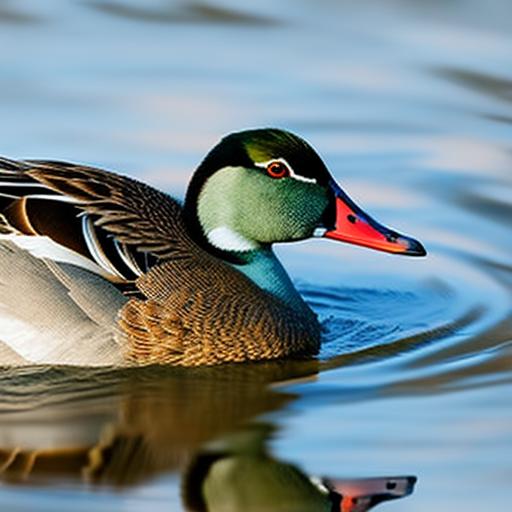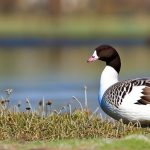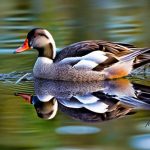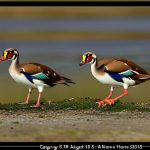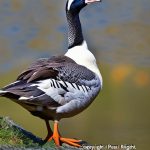Cross breeding ducks and geese is a practice that has been around for centuries, and it involves mating two different breeds of ducks or geese to produce offspring with desirable traits from both parent breeds. This process can result in hybrid ducks and geese that exhibit a combination of characteristics from each parent breed, such as improved disease resistance, better egg production, or superior meat quality. Cross breeding can also lead to the development of new breeds that possess unique traits not found in either parent breed. Understanding the basics of cross breeding ducks and geese is essential for anyone interested in engaging in this practice.
To begin with, it is important to have a good understanding of the genetics involved in cross breeding ducks and geese. Each breed of duck or goose has its own set of genetic traits that determine its physical characteristics, behavior, and other attributes. When two different breeds are crossed, the genetic material from each parent is combined in the offspring, resulting in a mix of traits from both parent breeds. This can lead to a wide range of outcomes, from offspring that closely resemble one parent breed to those that exhibit a more even mix of traits from both parent breeds. Understanding how these genetic traits are inherited and expressed in the offspring is crucial for successful cross breeding.
In addition to genetics, it is also important to consider the practical aspects of cross breeding ducks and geese. This includes understanding the reproductive biology of ducks and geese, as well as the specific requirements for housing, feeding, and caring for the birds. Ducks and geese have different mating behaviors and reproductive cycles, so it is important to be familiar with these differences in order to successfully cross breed them. Overall, a solid understanding of the basics of cross breeding ducks and geese is essential for anyone looking to engage in this practice.
Selecting the Ideal Breeds for Cross Breeding
When it comes to cross breeding ducks and geese, selecting the ideal breeds is a crucial step in the process. The goal of cross breeding is to produce offspring with desirable traits from both parent breeds, so it is important to carefully consider the characteristics of each breed before making a selection. This includes evaluating traits such as egg production, meat quality, disease resistance, and temperament, as well as any other specific traits that are important to the breeder. By selecting the right breeds for cross breeding, breeders can maximize the chances of producing offspring with the desired traits.
In general, breeders should look for breeds that complement each other well in terms of their genetic traits. For example, if one breed is known for its high egg production and the other is known for its superior meat quality, crossing these two breeds may result in offspring that exhibit both of these traits. Similarly, if one breed is known for its disease resistance and the other is known for its calm temperament, crossing these two breeds may produce offspring that are both healthy and easy to handle. By carefully selecting the ideal breeds for cross breeding, breeders can create offspring that possess a combination of desirable traits from both parent breeds.
In addition to genetic traits, breeders should also consider the practical aspects of cross breeding when selecting the ideal breeds. This includes evaluating the compatibility of the breeds in terms of their mating behaviors, reproductive cycles, and overall suitability for cross breeding. Some breeds may be more difficult to cross breed than others, so it is important to take these factors into account when making a selection. Overall, selecting the ideal breeds for cross breeding is a critical step in the process, and it requires careful consideration of both genetic traits and practical considerations.
Creating the Perfect Environment for Cross Breeding
Creating the perfect environment for cross breeding ducks and geese is essential for the success of the breeding program. This includes providing the birds with a suitable living space, as well as ensuring that their nutritional and environmental needs are met. Ducks and geese have specific requirements for housing, feeding, and care, so it is important to create an environment that is conducive to successful cross breeding.
One of the most important aspects of creating the perfect environment for cross breeding is providing the birds with a suitable living space. This includes providing them with a clean, spacious area where they can mate and raise their offspring. Ducks and geese require access to water for mating and grooming, so it is important to provide them with a suitable water source, such as a pond or shallow pool. In addition, the birds should have access to plenty of space for mating and nesting, as well as protection from predators and the elements. By providing the birds with a suitable living space, breeders can create an environment that is conducive to successful cross breeding.
In addition to housing, it is also important to ensure that the nutritional and environmental needs of the birds are met. Ducks and geese have specific dietary requirements, so it is important to provide them with a balanced diet that meets their nutritional needs. This includes providing them with access to fresh water, as well as a diet that is high in protein and other essential nutrients. In addition, the birds should have access to a clean, healthy environment that is free from toxins and other potential hazards. By creating an environment that meets the nutritional and environmental needs of the birds, breeders can create the perfect environment for successful cross breeding.
Managing the Mating Process for Successful Hybridization
Managing the mating process is a crucial aspect of cross breeding ducks and geese, and it requires careful planning and attention to detail. Ducks and geese have specific mating behaviors and reproductive cycles, so it is important to understand these processes in order to successfully manage the mating process for hybridization. This includes understanding the timing of mating, as well as the behaviors and interactions of the birds during the mating process.
One of the key aspects of managing the mating process for successful hybridization is understanding the timing of mating. Ducks and geese have specific reproductive cycles, and the timing of mating can have a significant impact on the success of the breeding program. For example, ducks and geese typically mate in the spring, so it is important to plan the breeding program accordingly. By understanding the timing of mating and planning the breeding program accordingly, breeders can maximize the chances of successful hybridization.
In addition to timing, it is also important to understand the behaviors and interactions of the birds during the mating process. Ducks and geese have specific mating behaviors, and it is important to be familiar with these behaviors in order to successfully manage the mating process. This includes understanding the courtship behaviors of the birds, as well as the interactions between males and females during mating. By understanding these behaviors and interactions, breeders can effectively manage the mating process for successful hybridization.
Overall, managing the mating process for successful hybridization requires careful planning and attention to detail. By understanding the timing of mating and the behaviors and interactions of the birds during the mating process, breeders can maximize the chances of successful hybridization.
Caring for Hybrid Duck and Geese Offspring
Caring for hybrid duck and geese offspring is an important aspect of cross breeding, and it requires careful attention to the specific needs of the birds. Hybrid offspring may exhibit a combination of traits from both parent breeds, so it is important to provide them with the appropriate care and attention in order to ensure their health and well-being. This includes providing them with a suitable living space, as well as meeting their nutritional and environmental needs.
One of the most important aspects of caring for hybrid duck and geese offspring is providing them with a suitable living space. This includes providing them with a clean, spacious area where they can grow and develop, as well as protection from predators and the elements. Ducks and geese have specific requirements for housing, so it is important to provide them with a suitable living space that meets their needs. By providing the offspring with a suitable living space, breeders can ensure their health and well-being.
In addition to housing, it is also important to ensure that the nutritional and environmental needs of the offspring are met. Ducks and geese have specific dietary requirements, so it is important to provide the offspring with a balanced diet that meets their nutritional needs. This includes providing them with access to fresh water, as well as a diet that is high in protein and other essential nutrients. In addition, the offspring should have access to a clean, healthy environment that is free from toxins and other potential hazards. By meeting the nutritional and environmental needs of the offspring, breeders can ensure their health and well-being.
Overall, caring for hybrid duck and geese offspring requires careful attention to their specific needs. By providing them with a suitable living space and meeting their nutritional and environmental needs, breeders can ensure the health and well-being of the offspring.
Maximizing the Benefits of Hybrid Ducks and Geese
Maximizing the benefits of hybrid ducks and geese is a key goal for breeders engaged in cross breeding, and it requires careful planning and attention to detail. Hybrid ducks and geese can exhibit a combination of desirable traits from both parent breeds, such as improved disease resistance, better egg production, or superior meat quality. By maximizing the benefits of hybrid ducks and geese, breeders can create offspring that possess a wide range of desirable traits.
One of the key ways to maximize the benefits of hybrid ducks and geese is to carefully select the ideal breeds for cross breeding. By selecting breeds that complement each other well in terms of their genetic traits, breeders can create offspring that exhibit a combination of desirable traits from both parent breeds. This can lead to a wide range of benefits, such as improved disease resistance, better egg production, or superior meat quality. By carefully selecting the ideal breeds for cross breeding, breeders can maximize the benefits of hybrid ducks and geese.
In addition to genetic traits, it is also important to consider the practical aspects of maximizing the benefits of hybrid ducks and geese. This includes creating a suitable environment for cross breeding, managing the mating process effectively, and providing the offspring with the appropriate care and attention. By carefully managing these aspects of cross breeding, breeders can maximize the chances of producing offspring with the desired traits. Overall, maximizing the benefits of hybrid ducks and geese requires careful planning and attention to detail, but it can lead to the creation of offspring with a wide range of desirable traits.
Overcoming Challenges in Cross Breeding Ducks and Geese
Cross breeding ducks and geese can present a number of challenges for breeders, and it is important to be aware of these challenges in order to successfully navigate the breeding process. One of the key challenges in cross breeding is managing the genetic diversity of the offspring. When two different breeds are crossed, the genetic material from each parent is combined in the offspring, resulting in a mix of traits from both parent breeds. This can lead to a wide range of outcomes, from offspring that closely resemble one parent breed to those that exhibit a more even mix of traits from both parent breeds. Managing this genetic diversity can be a challenge for breeders, as it requires careful planning and attention to detail.
In addition to genetic diversity, another challenge in cross breeding ducks and geese is managing the mating process effectively. Ducks and geese have specific mating behaviors and reproductive cycles, so it is important to understand these processes in order to successfully manage the mating process for hybridization. This includes understanding the timing of mating, as well as the behaviors and interactions of the birds during the mating process. By managing the mating process effectively, breeders can maximize the chances of successful hybridization.
Overall, overcoming the challenges in cross breeding ducks and geese requires careful planning and attention to detail. By managing the genetic diversity of the offspring and effectively managing the mating process, breeders can successfully navigate the breeding process and create offspring with a wide range of desirable traits.
Breeding for Desired Traits in Hybrid Ducks and Geese
Breeding for desired traits in hybrid ducks and geese is a key goal for breeders engaged in cross breeding, and it requires careful planning and attention to detail. By carefully selecting the ideal breeds for cross breeding and managing the mating process effectively, breeders can create offspring that possess a wide range of desirable traits. This can include traits such as improved disease resistance, better egg production, or superior meat quality. By breeding for these desired traits, breeders can create offspring that exhibit a combination of characteristics from both parent breeds.
One of the key ways to breed for desired traits in hybrid ducks and geese is to carefully select the ideal breeds for cross breeding. By selecting breeds that complement each other well in terms of their genetic traits, breeders can create offspring that exhibit a combination of desirable traits from both parent breeds. This can lead to a wide range of benefits, such as improved disease resistance, better egg production, or superior meat quality. By carefully selecting the ideal breeds for cross breeding, breeders can maximize the chances of producing offspring with the desired traits.
In addition to genetic traits, it is also important to consider the practical aspects of breeding for desired traits in hybrid ducks and geese. This includes creating a suitable environment for cross breeding, managing the mating process effectively, and providing the offspring with the appropriate care and attention. By carefully managing these aspects of cross breeding, breeders can maximize the chances of producing offspring with the desired traits. Overall, breeding for desired traits in hybrid ducks and geese requires careful planning and attention to detail, but it can lead to the creation of offspring with a wide range of desirable traits.
Marketing and Selling Hybrid Ducks and Geese
Marketing and selling hybrid ducks and geese is an important aspect of cross breeding, and it requires careful planning and attention to detail. Once the offspring have been successfully bred, it is important to effectively market and sell them in order to generate a profit and promote the breeding program. This includes developing a marketing strategy, identifying potential buyers, and effectively promoting the benefits of hybrid ducks and geese.
One of the key aspects of marketing and selling hybrid ducks and geese is developing a marketing strategy. This includes identifying the target market for the offspring, as well as developing a plan for reaching potential buyers. For example, if the offspring possess desirable traits such as improved disease resistance or superior meat quality, the marketing strategy may focus on promoting these benefits to potential buyers. By developing a marketing strategy, breeders can effectively promote the benefits of hybrid ducks and geese and attract potential buyers.
In addition to developing a marketing strategy, it is also important to identify potential buyers for the offspring. This may include contacting other breeders, farmers, or individuals who are interested in raising ducks and geese. By identifying potential buyers, breeders can effectively promote the benefits of hybrid ducks and geese and generate interest in the offspring. Overall, marketing and selling hybrid ducks and geese requires careful planning and attention to detail, but it can lead to increased profitability and success for breeders. By understanding the market demand and reaching out to potential buyers, breeders can establish a strong customer base and create a steady stream of income from selling their hybrid offspring. Additionally, building relationships with buyers can lead to repeat business and positive word-of-mouth referrals, further solidifying the breeder’s reputation in the industry. Ultimately, a well-executed marketing and sales strategy can result in a thriving business for breeders of hybrid ducks and geese.
Meet Walter, the feathered-friend fanatic of Florida! Nestled in the sunshine state, Walter struts through life with his feathered companions, clucking his way to happiness. With a coop that’s fancier than a five-star hotel, he’s the Don Juan of the chicken world. When he’s not teaching his hens to do the cha-cha, you’ll find him in a heated debate with his prized rooster, Sir Clucks-a-Lot. Walter’s poultry passion is no yolk; he’s the sunny-side-up guy you never knew you needed in your flock of friends!

